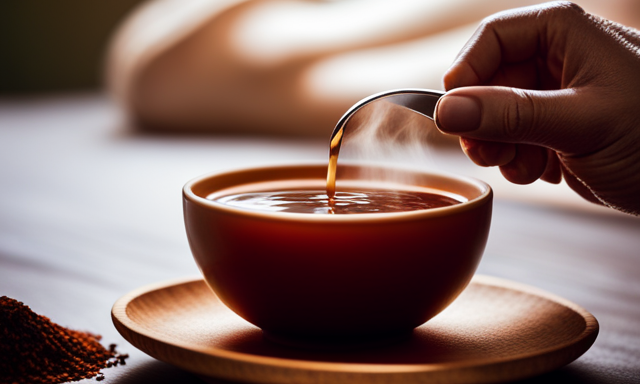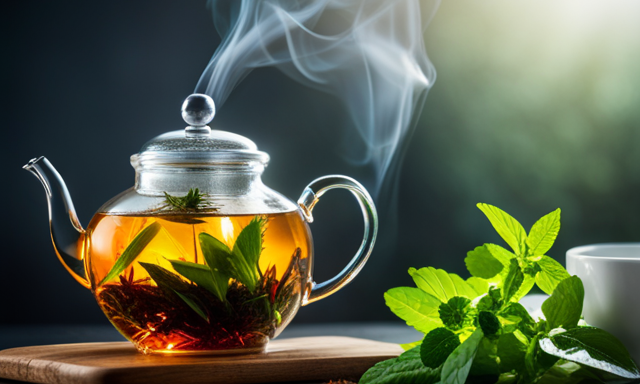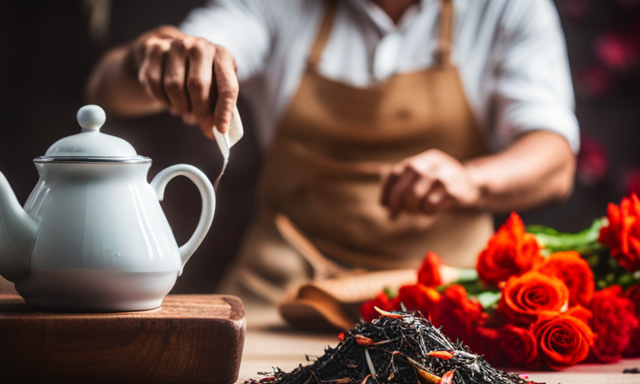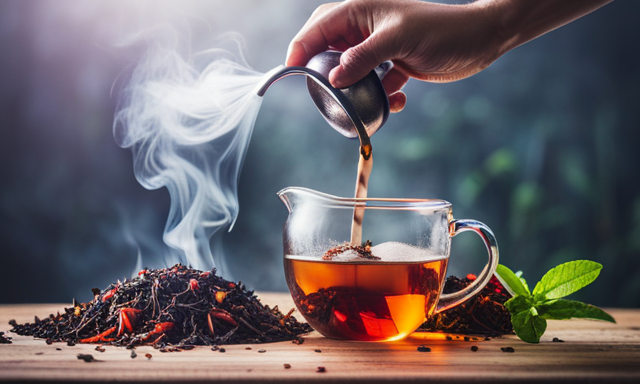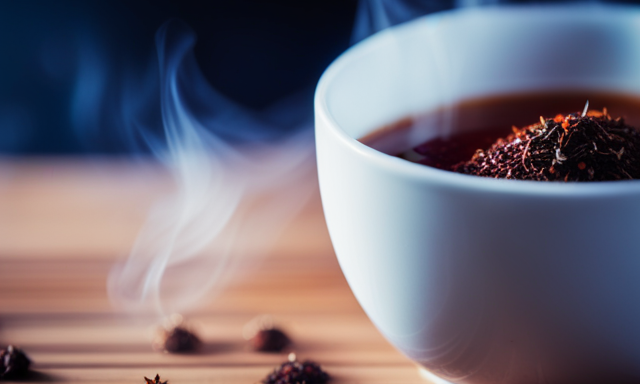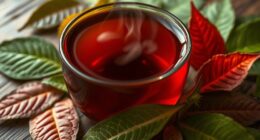As I sit here sipping on my warm cup of rooibos tea, the soothing aroma envelops me, transporting me to a world of relaxation and rejuvenation. Little did I know that this humble beverage could also work wonders for my skin.
Rooibos tea, derived from the South African plant Aspalathus linearis, is packed with antioxidants and various nutrients that can benefit our skin in numerous ways. From cleansing and soothing irritated skin to treating acne and blemishes, the potential of rooibos tea as a skincare ingredient is truly remarkable.
In this article, I will guide you through the process of harnessing the power of rooibos tea for your skin. Together, we will explore the preparation methods, the different ways to apply it, and the potential benefits it can offer.
So, let’s dive in and discover the transformative properties of rooibos tea for our skin.
Key Takeaways
- Rooibos tea can be applied on the skin as a toner, face mist, or in DIY face masks.
- Properly brew and cool the Rooibos tea before applying it to the skin.
- Rooibos tea has benefits for various skin concerns such as acne, oily skin, dry skin, and aging.
- Consistency and incorporating Rooibos tea into a daily skincare routine is important to maximize its benefits on the skin.
Understand the Benefits of Rooibos Tea for Skin
Discover the amazing benefits of using rooibos tea on your skin and see how it can transform your complexion! Rooibos tea, also known as red bush tea, isn’t just a delightful beverage but also a potent ingredient for skincare.
Drinking rooibos tea has been linked to numerous benefits for the skin. It can reduce inflammation, promote collagen production, and protect against UV damage. Incorporating rooibos tea in skincare products can provide similar advantages.
Its high antioxidant content helps fight off free radicals, which can cause premature aging and skin damage. Additionally, rooibos tea is rich in minerals like zinc and alpha hydroxy acids, which can help exfoliate and brighten the skin.
Now, let’s delve into how to prepare rooibos tea for skincare.
Prepare Rooibos Tea for Skincare
When it comes to preparing Rooibos tea for skincare, there are a few key points to keep in mind. First, consider the brewing method. I personally prefer to steep the tea bags in hot water for at least five minutes to ensure maximum flavor and potency.
Second, choose organic and pure Rooibos tea to avoid any potential pesticides or additives that could irritate the skin.
Lastly, once brewed, allow the tea to cool before using it on your skin and store any leftover tea in the refrigerator to maintain its freshness and effectiveness.
Brewing Methods
To brew a refreshing cup of rooibos tea, start by bringing water to a boil and then steeping the tea leaves for at least five minutes. There are different brewing techniques you can try to enhance the flavor and benefits of the tea. Here are some options to consider:
-
Traditional Method: Boil water and pour it over the tea leaves. Let it steep for 5-7 minutes before straining.
-
Cold Brew: Place tea leaves in cold water and refrigerate overnight. This method results in a smoother, less bitter taste.
-
Sun Tea: Place tea leaves in a jar of water and let it sit in direct sunlight for a few hours. This method can bring out a unique flavor profile.
Once you have brewed your rooibos tea, the best time to apply it on your skin is after cleansing and before moisturizing. It can be used as a toner or a facial mist.
Now, let’s move on to the next section about choosing organic and pure rooibos tea.
Choosing Organic and Pure Rooibos Tea
Opting for organic and pure rooibos tea ensures that you’re savoring a cup of nature’s goodness without any harmful additives or chemicals. When choosing organic tea, look for certifications from reputable organizations such as USDA Organic or Fairtrade. These certifications guarantee that the tea has been grown without the use of synthetic pesticides or fertilizers, and that fair labor practices have been followed.
Finding high quality tea is also important to fully enjoy the benefits of rooibos on your skin. Look for tea that’s sourced from reputable suppliers and has a vibrant red color and a fragrant aroma. Loose leaf tea is often considered to be of higher quality than tea bags, as it allows the leaves to fully expand and release their flavor.
Once you’ve chosen your organic and pure rooibos tea, the next step is to learn how to properly cool and store it.
Cooling and Storing the Tea
After brewing a refreshing cup of organic and pure rooibos tea, it’s time to cool it down and find the perfect spot in your kitchen to store it.
To ensure optimal taste and quality, there are a few cooling techniques you can employ. Firstly, let the tea cool naturally at room temperature before transferring it to the refrigerator. This gradual cooling process helps retain the delicate flavors and antioxidants present in the tea.
Additionally, avoid adding ice to speed up the cooling process, as it can dilute the tea and diminish its potency.
Once cooled, store the tea in an airtight container away from direct sunlight and strong odors. This long-term storage technique will help preserve the tea’s freshness and flavor for an extended period.
Now that your rooibos tea is ready, let’s move on to how you can cleanse your skin with it.
Cleanse Your Skin with Rooibos Tea
Start by gently massaging your skin with a rooibos tea-infused cleanser, allowing the soothing properties to penetrate your pores.
Rooibos tea is not only delicious to drink, but it also offers numerous benefits for your skin. It’s rich in antioxidants and minerals, which can help improve your skin’s overall health. By incorporating rooibos tea into your daily routine, you can provide your skin with a natural boost of hydration and protection against environmental stressors.
The antioxidants in rooibos tea can help reduce inflammation and redness, while the minerals nourish and revitalize your skin. After cleansing with the tea-infused cleanser, your skin will feel refreshed and ready for the next step of your skincare routine.
Soothe and calm irritated skin with the next section.
Soothe and Calm Irritated Skin
If you’ve been dealing with irritated skin, there’s nothing better than finding a gentle and effective solution to bring relief. Imagine having a product that effortlessly soothes redness and reduces inflammation, leaving you with a soothing and comfortable complexion.
Rooibos tea can be just the solution you need. This powerful herbal tea is packed with antioxidants and anti-inflammatory properties that help calm irritated skin. The soothing effects of rooibos tea can alleviate redness and inflammation, providing instant relief. Its natural properties work to rejuvenate and nourish your skin, making it a great addition to your skincare routine.
So, if you’re looking for a natural remedy to soothe and calm your irritated skin, give rooibos tea a try. It’s a simple and effective way to achieve a more comfortable and healthy complexion.
Rejuvenate and Nourish Your Skin
After soothing and calming irritated skin, it’s time to rejuvenate and nourish your skin with the power of rooibos tea. This natural ingredient is packed with antioxidants and nutrients that can help revitalize your skin, leaving it looking refreshed and radiant. Here are four ways rooibos tea can work wonders for your skin:
-
Rejuvenate: The antioxidants in rooibos tea help combat free radicals that contribute to aging, helping to reduce the appearance of fine lines and wrinkles.
-
Restore moisture: Rooibos tea is rich in minerals and vitamins that can nourish and hydrate dry skin, leaving it soft and supple.
-
Improve complexion: The anti-inflammatory properties of rooibos tea can help calm redness and irritation, promoting a more even skin tone.
-
Boost collagen production: The natural alpha hydroxy acids found in rooibos tea can stimulate collagen production, helping to improve skin elasticity and firmness.
With rooibos tea, you can give your skin the rejuvenation and nourishment it deserves. Now, let’s explore how to treat acne and blemishes for a clearer complexion.
Treat Acne and Blemishes
When it comes to treating acne and blemishes, using Rooibos tea can be highly beneficial. As someone who’s struggled with acne, I’ve found that incorporating Rooibos tea into my skincare routine has helped reduce breakouts and improve my skin’s overall appearance. One way to use Rooibos tea is by making a spot treatment. Simply brew a cup of Rooibos tea, let it cool, and then apply it directly to any acne spots.
Additionally, Rooibos tea can also help combat oily skin. It contains natural antioxidants that help regulate sebum production and reduce excess oil.
Using Rooibos Tea to Reduce Acne
Using Rooibos tea is a fantastic way to effectively reduce acne and achieve clearer skin. When it comes to treating acne, many people are turning to natural remedies, and the benefits of herbal remedies like Rooibos tea can’t be overlooked.
Rooibos tea is rich in antioxidants that help fight inflammation and reduce the production of sebum, the oily substance that can clog pores and lead to acne. Additionally, Rooibos tea has antimicrobial properties that can kill the bacteria responsible for acne breakouts.
By incorporating Rooibos tea into your skincare routine, you can naturally reduce acne and promote healthier skin.
In the next section, I’ll explain how to make a Rooibos tea spot treatment to target specific acne spots and further enhance the effectiveness of this natural remedy.
Making a Rooibos Tea Spot Treatment
After learning about the benefits of using Rooibos tea to reduce acne, let’s now delve into making a Rooibos tea spot treatment. This DIY method is a simple yet effective way to target and treat pesky blemishes.
Rooibos tea contains antioxidants that help combat inflammation and soothe irritated skin. To make the spot treatment, brew a cup of Rooibos tea and let it cool completely. Then, dip a cotton ball into the tea and gently dab it onto the affected areas. Leave it on for about 15 minutes before rinsing off with lukewarm water.
The antibacterial properties of Rooibos tea will help reduce redness and swelling, promoting faster healing. Now that we have tackled acne, let’s move on to combating oily skin with the help of Rooibos tea.
Combating Oily Skin with Rooibos Tea
To combat oily skin, you can harness the power of Rooibos tea to control excess shine and promote a healthier complexion. Rooibos tea is packed with antioxidants and minerals that help regulate sebum production, the main culprit behind oily skin. Its natural astringent properties also tighten and minimize the appearance of pores, giving your skin a smoother and more refined look.
Additionally, Rooibos tea is known for treating dry skin and preventing premature aging. Its hydrating properties nourish and moisturize the skin, reducing dry patches and fine lines. By incorporating Rooibos tea into your skincare routine, you can enhance your skin’s health and appearance.
Transitioning into the next section, let’s explore how to further enhance your skincare routine with the amazing benefits of Rooibos tea.
Enhance Your Skincare Routine with Rooibos Tea
Want to take your skincare routine to the next level? Enhance it with the amazing benefits of rooibos tea! This natural ingredient has numerous advantages for your skin, making it a perfect addition to your daily regimen.
Here are five reasons why you should incorporate rooibos tea into your skincare routine:
-
Antioxidant-rich: Rooibos tea is packed with antioxidants that help fight free radicals, reducing the signs of aging and promoting a youthful complexion.
-
Soothing properties: The anti-inflammatory properties of rooibos tea can calm irritated skin, reducing redness and inflammation.
-
Moisturizing effect: Rooibos tea contains natural oils that provide deep hydration, leaving your skin soft and supple.
-
Gentle exfoliation: The alpha hydroxy acid in rooibos tea gently exfoliates the skin, removing dead cells and revealing a brighter complexion.
-
Acne-fighting abilities: Rooibos tea’s antibacterial properties can help combat acne-causing bacteria, reducing breakouts and promoting clearer skin.
By adding rooibos tea to your skincare routine, you can enjoy these benefits and more.
In the next section, we’ll discuss some final tips for using rooibos tea on your skin.
Conclusion and Final Tips for Using Rooibos Tea on Your Skin
Take your skincare routine to the next level and unlock the secret to radiant skin by harnessing the power of rooibos tea – it’s like a refreshing sip of nature’s elixir for your complexion! To maximize the benefits of rooibos tea on your skin, consistency is key.
Make it a habit to incorporate rooibos tea into your daily skincare routine. Whether you choose to use it as a toner, face mist, or in DIY face masks, using rooibos tea regularly can help soothe and hydrate your skin, reduce inflammation, and promote a more youthful complexion.
Remember to brew the tea properly to extract the most antioxidants and allow it to cool before applying it to your skin. Trust me, the final results will be worth it!
So, make rooibos tea your go-to skincare ingredient and enjoy the beautiful and healthy skin you deserve.
Frequently Asked Questions
Can rooibos tea be used on all skin types?
Yes, rooibos tea can be used on all skin types. It has numerous benefits for the skin, including soothing and calming properties, making it particularly beneficial for sensitive skin.
Is it safe to apply rooibos tea directly on the skin without diluting it?
It is safe to apply rooibos tea directly on the skin without diluting it. Rooibos tea has potential benefits for skin health, such as reducing inflammation and promoting a youthful complexion. However, it is still important to patch test and monitor for any adverse reactions.
How long should I leave rooibos tea on my skin for maximum benefits?
For maximum benefits, leave rooibos tea on your skin for 10-15 minutes before rinsing. The antioxidants in rooibos tea can help soothe and protect the skin, reducing inflammation and promoting a healthy complexion.
Can rooibos tea help with reducing the appearance of fine lines and wrinkles?
Rooibos tea can potentially help reduce the appearance of fine lines and wrinkles. Its hydrating properties can improve skin elasticity, making it look smoother and more youthful.
Are there any potential side effects or allergic reactions to using rooibos tea on the skin?
There are potential risks and allergic reactions associated with using rooibos tea on the skin. It is important to be aware of these before applying it topically.
Conclusion
In conclusion, incorporating Rooibos tea into your skincare routine can have numerous benefits for your skin. It’s anti-inflammatory and antioxidant properties help to soothe and calm irritated skin, while also rejuvenating and nourishing it. Additionally, Rooibos tea can be effective in treating acne and blemishes, helping to improve the overall appearance of your complexion. By adding this natural ingredient to your skincare regimen, you can enhance the effectiveness of your routine and achieve healthier, glowing skin.
So go ahead and let Rooibos tea be the soothing balm that revitalizes your skin, just like a gentle breeze on a warm summer day.

